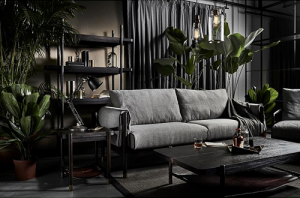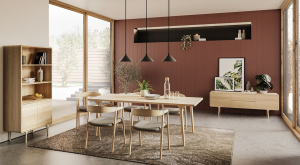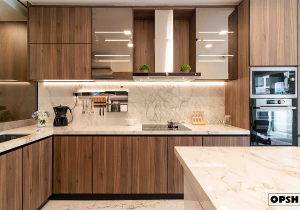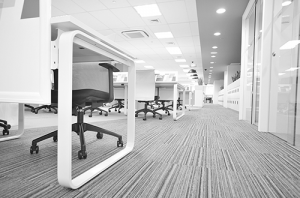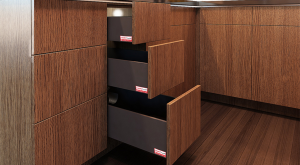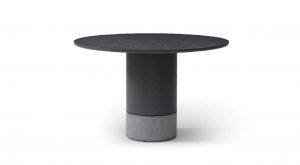To Embrace and Evolve: Speaking to Emily Sim, Director of Panelogue & SUPERSTRUCTURE
A second-generation leader of the furniture industry, Emily Sim has been growing her two brands, Panelogue and Superstructure as an extension from NS Trading, her parent’s timber and engineered wood panels distribution company. Find out how she is leading the charge to embrace the beauty – and sustainability – of wood, and evolving the industry for the next generation.
You’ve started not one, but two companies – Panelogue in 2016 and Superstructure in 2017. What is each brand about?
With Panelogue, I distribute engineered wood-based panels, and specialise in wood-based technology advisory for my clients. The view is towards encouraging the adoption of safer and more sustainable materials in the furniture industry.
Superstructure is its sister brand which we conceive of as a bridge between design and manufacturing. We are a rationalisation studio that helps designers to realise their designs through the use of computational design and design for manufacturing and assembly.
What made you decide to start Panelogue?
Panelogue began with my desire to bring in more innovative materials to the local market. This is not something that many people want to do, because it requires time and effort to consult with clients to share about the value of the materials. A big part of this work is education – to share about why innovative, safe and sustainable materials are worth exploring rather than the traditional go-to materials.

What are some materials that Panelogue carries which you’re excited about?
Onewood is a Singaporean invention – it’s reconstituted wood that’s very versatile and hardy, exactly like wood. Previously, you’d have to cut down trees that are 50 to 100 years old to obtain termite-resistant or termite-proof wood to build structures such as decking. But what do we do when these trees don’t exist anymore? What’s so beautiful about Onewood is that it replaces the need to cut down these very old trees.
Onewood uses plantation logs, fast-growing trees that mature in 8 to 10 years. What they do is they peel it like a toilet roll, and then they reconstitute it under high heat and pressure. This enables the wood from young trees to become as strong as that of old trees like Chengal, which can then be used to construct a lot of different things – decks, staircases, trellis handrails, wall panels, everything.
The key here is the use of plantation logs, because it’s the way forward if we want the timber industry to be sustainable. People try to market plastic as being better than wood, ostensibly since logging destroys the forest. But I think this is complete greenwashing rubbish – because how can plastics ever be better than wood?
Wood is grown by the power of the sun. It has the capacity to construct 30-storey buildings as much as it can create the smallest toy, and it furthermore sequesters carbon. There’s no material on this earth that’s better than wood, in my opinion. What we should learn how to do is protect this natural renewable resource. Because while the concrete industry is limited by how much sand one can collect from the earth, wood is not, as long as we learn how to develop the industry in a sustainable way.

How has the reception towards Onewood been?
I mean, it’s growing. It’s been 10 years of sharing about this with consumers and industry partners and it continues to be all about education. For too long we as a society have been engrossed with buying the most exotic wood and the most exotic marble, and it’s hard to change people’s perception of luxury.
What other materials do you bring in which are new or interesting?
Cork, to me, has the most potential. The story of cork is beautiful, because it’s one of the only materials where you don’t have to kill the tree in order to harvest the material. It’s the bark of an oak tree – you skin it as you shear the wool off a sheep every nine years.

The first cut of cork is very thick, and it’s used to make cork stoppers. Then after that, the rest are crushed to make cork veneers. The tree itself is still left standing. And because cork is formed from the bark of the tree, it doesn’t all the traditional disadvantages of the inner layers of the tree. The bark is termite-resistant, water-resistant, and impact-resistant to protect the tree, so cork has these properties as well.
We also recently brought in Foresso, a material which resembles terrazzo but created using wood chips. The texture is closer to wood than marble, and can be treated like parquet. An up-and-coming café is using this for their interior.

These are materials which I feel require more care to explain. When people look at this material that seems like fake marble or less valuable, they’re likely to dismiss it without understanding the story of it.
What have you found challenging about sharing the stories of these materials?
Singapore’s market is not big enough to support more specialised materials. If you want to make a profit, it’s better to just offer something similar to what’s already on the market, that everybody can accept. The moment you try to deviate from the norm, there’s just simply not a large enough market here to support that niche for you to be successful financially.
Also, the thing with experimental materials is that everything is always new, so you always need to be on your toes. For natural materials, it is hard to get people to understand that natural materials will age with time, compared to laminates and other plastics. One of the most difficult things for me has been getting people to appreciate that things age over the course of time as they leave their mark on it.
On the other hand, because of the innovative materials that I distribute at Panelogue, I got to meet forward-thinking designers and architects.
Is that how Superstructure came about?
Yes – it’s led me to learn that one challenge designers seem to face is in realising the crazy design ideas that they have. Often, they’re met with a lack of support from the contractor or manufacturer, sometimes because of prohibitive costs. I thought, “Why is an architect’s ideas being held hostage by the main contractor about what to do?”
That in turn led me to explore digital fabrication. Initially, no one here believed that there was value in this, and I had to use my neighbour’s CNC machine at night, and ask him to teach me how to use it.

So Superstructure is born from these very real challenges, and our desire to enable designers to do something different, to design something out of the box.
By partnering with designers, we’re able to advise on the feasibility and costing of projects. We’ve found that clients are also then more confident about the project when they see that the price and feasibility has already been taken into consideration during the design process.

Do you have a favourite project that you’ve worked on at Superstructure?
This is a tough question… It’s always a learning experience. Whenever I pick up a project, I always try to ask myself what I want to learn out of it. If it’s a truly commercial project, we’d charge the full fee. Otherwise, we try to pick up projects that we can learn something from, because the exploratory process is what excites us.

How do you see Panelogue and Superstructure growing?
I see Panelogue growing hopefully to distribute more interesting, sustainable and innovative materials. In terms of the future of laminated surfaces, I really believe that wood is the future. It’s the only sustainable resource that we have, and I do see Panelogue as a platform for me to do my part to save the environment.
For Superstructure, there are currently many opportunities with concrete, 3D printing, and digital fabrication that we are excited to explore. I think that the world is also still exploring its possibilities, and we hope to bring ourselves to a global level.
[by Michelle JN Lim]
To find out more about Panelogue and Superstructure, check out their websites:
28 April 2021


